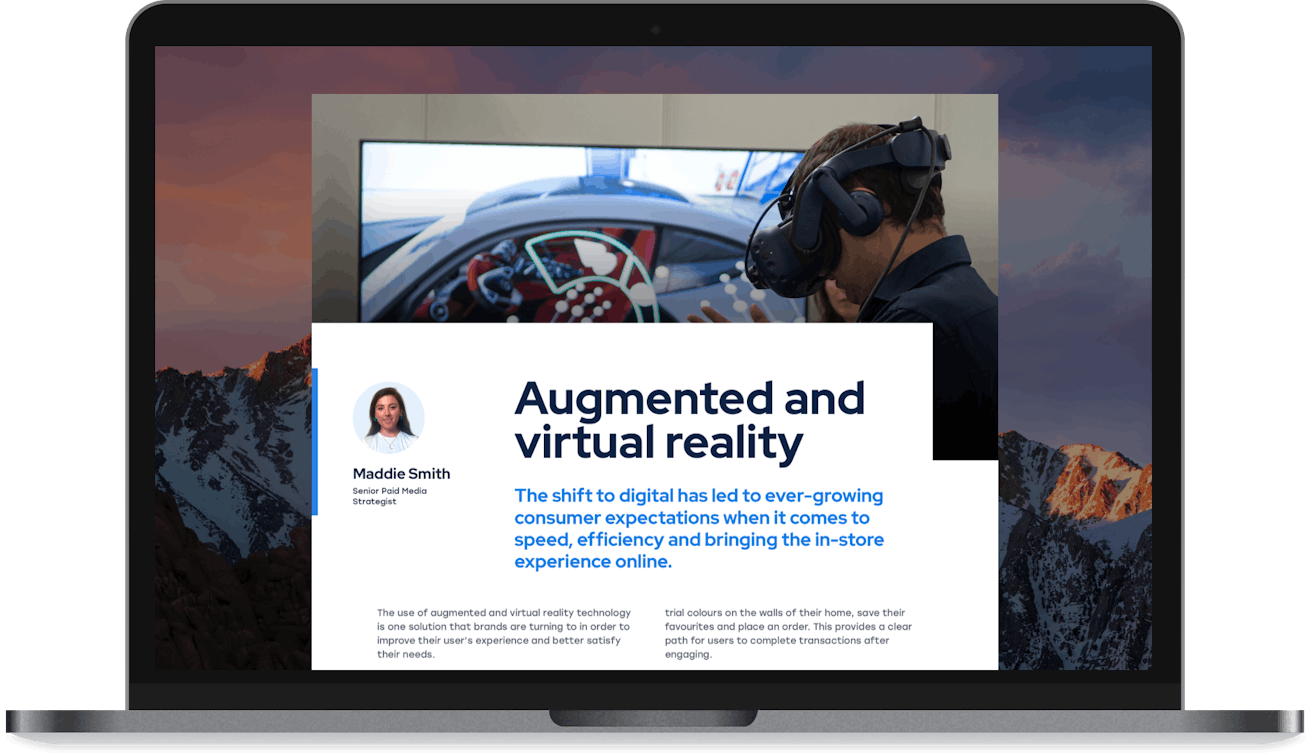Read the full guide below or click here to download it as a PDF.
- Introduction
- Augmented and virtual reality?
- Next step for marketers
- A future without cookies
- What is the cookieapocalypse??
- What is the impact of a future without cookies??
- Next steps for marketers
- Personalisation
- Next step for marketers
- Newsjacking and reactive PR
- Next step for marketers
- Sustainable ecommerce
- Next step for marketers
- Tapping into TikTok
- Next steps for marketers?
- Growth in shoppable social??
- Next steps for marketers?
- Google’s latest innovation?
- Next steps for marketers?
- Improving user experience?
- Next steps for marketers
- Navigating supply chain challenges?
- Next steps for marketers?
- Importance of differentiation other than price
- Next steps for marketers
- The rise of the Customer Data Platform
- Why are CDPs important?
- Next steps for marketers?
- Conclusion
Introduction
Online shopping has always been a popular activity but the pandemic has accelerated the shift to digital, introducing new behaviours and consumer trends. The way that people shop has fundamentally changed and as more have become comfortable with the process of shopping online, their demands and expectations have increased. Ecommerce marketers are having to do more to not only capture their customers’ attention but also to foster relationships in order to increase loyalty.
If you’re looking to grow your ecommerce business in 2022, you’ll need to pay close attention to the digital landscape as consumers’ shopping habits continue to evolve and new trends emerge. It’s more important than ever to be creative and innovative in your approach, adopting new techniques to stand out against your competitors. To help you stay ahead of the curve, we’ve asked our team of digital marketing experts which key trends they predict are worth considering as part of your online marketing strategy in 2022.
The advice in this guide has been collated from specialists across different digital marketing disciplines to give you a rounded view of which key themes are expected to impact the industry next year. We’ve made sure that our insights are actionable, providing you with concrete takeaways that will add meaningful value to your business.
Augmented and virtual reality

The shift to digital has led to ever-growing consumer expectations when it comes to speed, efficiency and bringing the in-store experience online. The use of augmented and virtual reality technology is one solution that brands are turning to in order to improve their user’s experience and better satisfy their needs.
Augmented reality technology provides customers with the option to ‘try before you buy’, or have unique experiences that they would typically find in-store. 76% of consumers say they would be much more likely to purchase if there was this “try-before-you-buy” option available online, with 40% saying they would actually spend more if they can experience products or services through AR.
Over the last year we’ve seen more and more brands implementing AR or VR experiences as part of their customer journey. Benefit Cosmetics developed its Try-On technology to allow a user to take a photo of themselves and alter the shape and thickness of their brows virtually.
Dulux’s Visualizer app allows customers to test a new paint colour in their home without even having to touch a brush. Using the app, users are able to trial colours on the walls of their home, save their favourites and place an order. This provides a clear path for users to complete transactions after engaging.
Brands that are investing into ARVR are already seeing the benefits. Houzz (an interior design and architectural app) stated that people who engaged with their tool were 11 times more likely to purchase.
ARVR technology can be utilised across the full-funnel, meeting consumer needs at every stage of their journey. Innovative experiences will spread word-of-mouth and capture new interest and awareness. Immersive AR puts consumers in control of trying your products and services, fast tracking them through the consideration phase to conversion. Offering highly personalised experiences give your brand the ability to captivate your customers, encouraging loyalty and brand retention.
Next step for marketers
Your brand may not be in a position to invest in its own unique app or service with ARVR capabilities, so the good news is that many marketing platforms can make the job much easier for you.
Social media provides possibly the most streamlined way of testing ARVR in your ecommerce journey. Facebook in particular makes the jump simple to play around with immersive content. Creative can utilise 3D photo images or panorama images turning into 360 images on mobile, meaning consumers can get a feel for your products by viewing them from all angles.
Snapchat offers brands the ability to create AR filters to promote their products and services, making it a great platform to test the technology out. The social media brand recently announced a new studio that will help brands build AR experiences not just for Snapchat, but for any other social platform, too!
Your brand could also utilise TikTok’s suite of AR offerings. TikTok’s “Branded Scan” lets you create an immersive branded experience. In 2020, TikTok announced new partnerships with Bare Tree Media, Subvrsive and Tommy that will aim to accelerate the use of 3D technology for brands, making the jump to AR much simpler.
For SEO, the rise of ARVR will become more crucial to consider for your content strategy. Major search engines such as Google, Bing and Yahoo support visual search, and experts predict that content will soon be crawled, indexed, and ranked higher in SERPs for AR-based content via visual search. Everything from digital content, to offline advertising, physical locations, brand and product photos and images will someday likely be searched through AR, so it’s important to consider how your brand can adapt to be more visible.
More and more retailers are tapping into ARVR. Don’t wait too long to consider whether your brand should explore this opportunity further to make virtual reality an actual reality.
The cookiepocalypse has been on the horizon for some time now. As we get closer to a cookieless world, what should you be doing to protect your marketing efforts in 2022?
Google originally announced it would phase out third-party cookies on Google Chrome by 2022 and aim for a “Privacy first web”. This was recently delayed by around a year to mid-2023. Whilst this buys marketers some more time, the earlier you can prepare, the better.
What is the cookieapocalypse?
Cookies are small pieces of data which are stored in a user’s web browser. These are commonly used for website functionality, but also heavily used for tracking and marketing purposes. Third party cookies specifically, are cookies which have been created by a website other than the one you are currently on. These cookies are often used by marketing platforms to track conversions but can also be used for tracking users across multiple websites. This data can then be used by you to build your audiences and create remarketing campaigns.
Data fidelity lost through third party cookie deprecation actually started years ago, so beware of the Google-centric echo chamber. In fact, Apple’s ITP started in 2018. There are some browsers, such as Safari and Firefox, that have already started blocking some third-party cookies to protect users’ privacy.
This has all resulted in the term “cookiepocalpse” taking hold!
What is the impact of a future without cookies?
- Less targeted ads – Third-party cookies are used to build a profile of a user. As an advertiser, you will then use this information to create audiences. With less information available, the accuracy of your targeted ads will reduce.
- Attribution accuracy – The ability to measure the effectiveness of your campaigns and how they are performing will become more difficult as advertising platforms will be unable to set unique identifiers in cookies.
- Loss of view-through conversions – Third-party cookies measure when your user views an ad but does not click it. This information gives you more insight into how well display ads are performing but will be mostly lost.
Next steps for marketers
Luckily, there are many practical steps that you can take to combat these challenges.
Carry out a Google Analytics health check
Ensure you have reliable and accurate Google Analytics deployment. Whilst some third-party analytics tools may suffer, bigger platforms such as Google Analytics will be less affected. Potential customers are likely utilising at least one other Google service. In this case these marketers can take advantage of permissions granted to other products and services within the Google ecosystem. A review of your Google Analytics implementation is a great way to check your particular deployment is correct and your data is accurate.
Focus on collecting first party data
As we move to a world with less reliance on third-party data sets, it’s important to start creating your own and building a customer database. This can be done through CRM integrations and through website micro conversions such as newsletter signups and content downloads. As this customer data is then owned by you, it can be uploaded to third-party platforms to build audience cohorts and power your marketing efforts.
Utilise server-side tagging
Google recently made server-side tagging available using Google Tag Manager. This method removes the reliance of client-side web tracking and moves it to a server environment. Recorded data is sent to a server-side container, which in turn passes the data to the third-party platforms.
This has several benefits…
You no longer need to load a javascript library per platform to track the same actions. For example, a conversion action can be sent once to your server container. This action can then be manipulated and passed to different platforms on the server which also reduces load on the browser.
Another benefit is that you will have full control on what data gets sent to each platform. This is because you can process it in your server-side container before shipping it.
Lastly, data collection is first party. Server-side containers can be deployed using one of your subdomains such as tracking.mywebsite.co.uk
The largest takeaway is that data capture and measurement data fidelity is irreversibly changing. It’s an adjustment that all marketers will need to adapt to in favour of end user privacy. There are privacy-safe solutions currently in development, but these will all lack the fidelity we’re used to as end user privacy is respected more and more over time.
It’s been incredibly common in past years for ecommerce sites to take on a very similar shape, structure and experience:
- Home page
- Category pages with filters
- Product pages with more detailed information and route to a basket
- Basket
- Checkout
Steve Krugg who wrote Don’t Make Me Think called this approach, “advanced common sense”. For a site to convert well your users should not have to learn how to use it first, they don’t have time. This meant we built similar sites to one another and a consistent user experience to prevent users from becoming confused.
This approach, however, lacks creativity and has limited the amount of interesting and diverse user experiences, leaving web designers working to a standard ecommerce template most of the time.
In 2022, this approach is set to change as technology and internet speeds continue to improve and devices we browse the web on evolve. These advancements are allowing web designers to break the mould by using dynamic content.
Dynamic content provides us with a much more engaging web experience. As a user scrolls down a page the content will shift and change rather than giving us an up and down scroll experience, our scrolls trigger changes in content which can happen from all directions. A good example of this is Apple’s iPhone 13 landing page.
When the user arrives at the Cinematic mode section, the content changes on a scroll action without the motion of moving down the page, for example;
Scroll 1
Shows us a video of cinematic focus effect on the new iPhone with content appearing underneath.
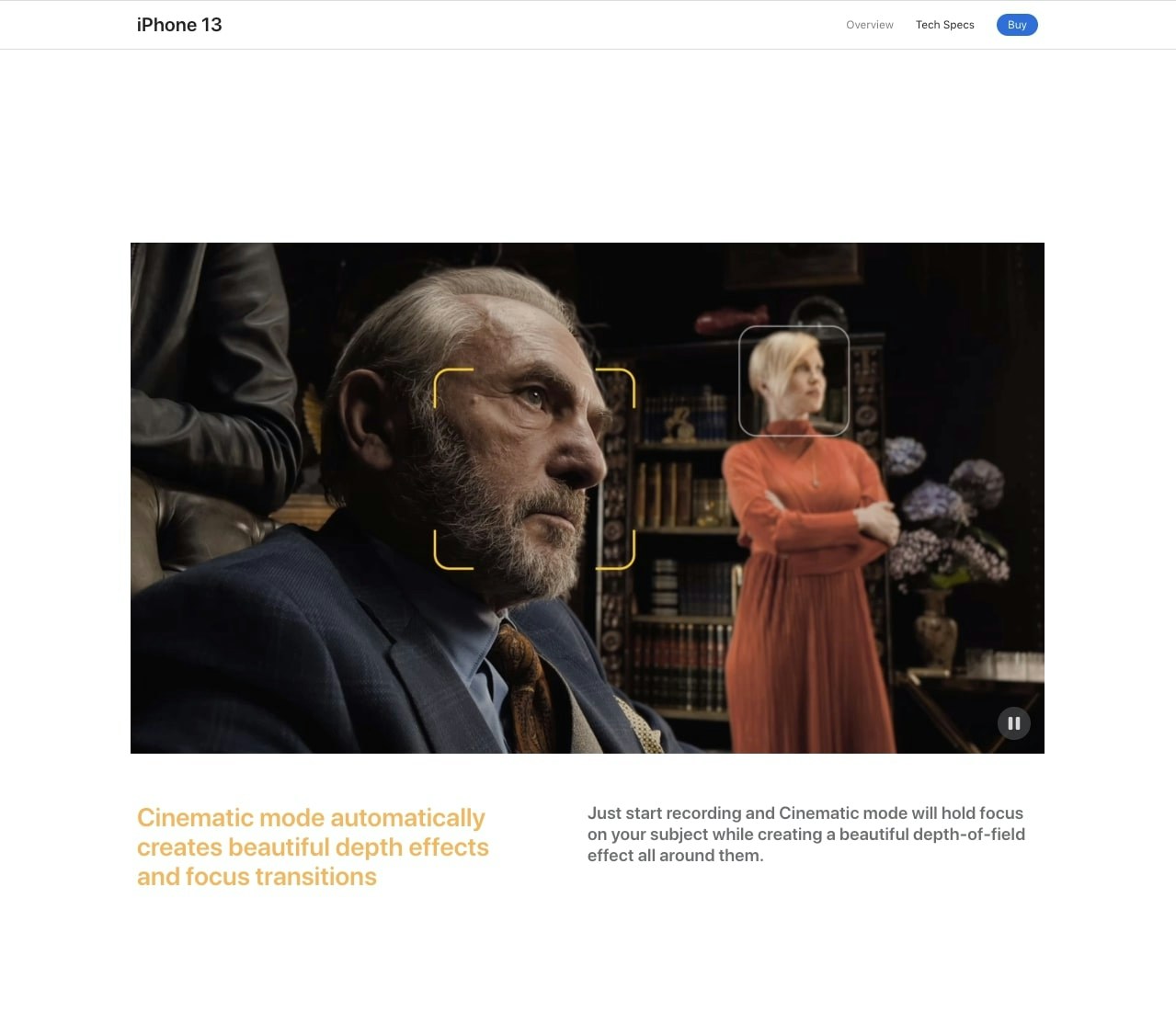
Scroll 2

Scroll 3
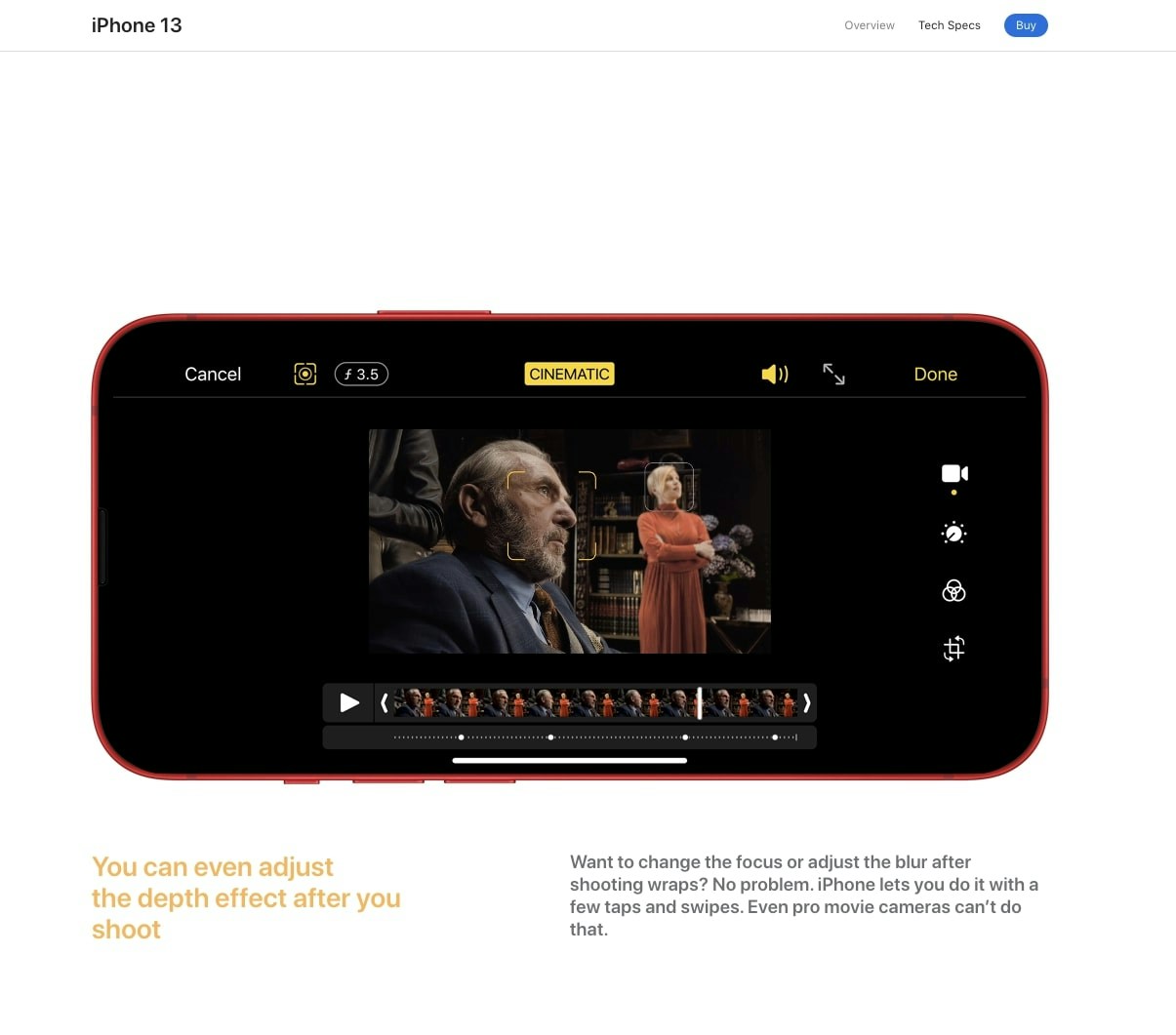
With dynamic content in mind, the first rule of design could change from “Don’t make me think” to “be interactive”.
If you’re looking to grow your business by generating more conversions from your existing traffic base, utilise A/B testing to learn which types of interactive experiences users engage with the most.
It’s important to consider that more complex experiences could result in a requirement for more complex coding, which could increase test development costs and production time. However, this should be viewed as an investment for your business given the improved user experience will lead to an uplift in sales, as proven by the results from your A/B testing.
Static wireframing and design flat panels could require a need for storyboarding states of a view port as the user scrolls through the experience. It’s worth bearing in mind that this might increase the levels of creativity required for designing new experiences.
The general structure of your ecommerce website could largely remain the same, but what happens on your pages could be very different from the current experience.
- Home page – Instead of a standard hero area slider, you may want to use dynamic content to allow a user to scroll through all of your offers before they hit the content underneath, for example. This could increase scroll depth.
- Category page – Dynamic content at a category stage of the user journey could provide a deeper look visually at products before clicking through to a product page. This could entice more users to click through as it’s more interesting at this stage of the buyer journey.
- Product page – For a more immersive experience, present users with different images containing information, stats, reviews and USPs. These are all more easily absorbed by the user in its dynamic state.
Dynamic content can also benefit the landing pages for your key paid search, social and email marketing campaigns. Driving users from these campaigns to a landing page that delivers clear, concise information per scroll while keeping the user in a visually static window has its advantages. Information is delivered in stages on scroll triggered by the user when they are ready. This slows down information, making it easier to digest than current methods. This could reduce scan reading, bounce rates and allow key information to be better absorbed by the user, leading to higher engagement and conversion rates.
Next step for marketers
As this trend continues to grow, websites that don’t adopt a more interactive experience could start to experience higher bounce and exit rates. Your site also risks being labelled as boring, especially by younger audiences who will adapt to it first. As more people experience dynamic content, the demand and expectation for this type of content increases.
The good news is that the technology that it takes to do this should already be in place on your website. To create the animations and immersive experience that Apple has, you only need some standard web codes, JavaScript and CSS.
Ask your developers about using CSS transform and opacity animations as a starting point on your journey to creating more immersive experiences.
It’s likely that your digital PR strategy has changed a lot since the start of the pandemic. Many journalists were placed on furlough and it became increasingly hard to ‘cut through the noise’ when the media was dominated by news of the virus – and rightly so. This resulted in a complete reevaluation of strategies.
Due to the rapidly changing media landscape, it was clear that the ability to be reactive and adopt a flexible approach was imperative to seeing success. A Google search for “reactive PR” and “Covid” will show you just how much of a learning curve this last year or so has been!
Whilst newsjacking and reactive PR tactics – the process of reacting quickly to stories in the news to gain coverage – are nothing new, they have certainly become a larger part of our strategies and we predict this is a theme that will continue into 2022. This could mean anything from providing a journalist with a snappy comment for their breaking story to creating a ‘thought leadership’ campaign around a hot (or rising) topic.
We saw our own clients have a lot of success with this over the last 12-18 months. My new plant obsession inspired me to put together a campaign looking at the top indoor houseplants of 2021, for an ecommerce brand that sold plant pots. But this wasn’t just my obsession – journalists were talking about it too; my lightbulb moment came when I read a Guardian article called ‘unwatered office plants of lockdown – in pictures’.
We gathered data via a survey that was hosted on the client’s site, and through keyword research. The result? Nine followed links from sites including The Independent, Stylist, Real Homes and Lux Review, with an average domain rating (DR) of 58. Seven of those links pointed to either the target directory (a dedicated landing page for the purpose of the campaign), or a relevant product page, helping to boost the campaign’s SEO value. Along with SEO support, the client’s rankings increased by 89 places for the term ‘wholesale planters’ and 94 places for the term ‘wholesale indoor planters’, over the course of the last year.
It’s getting harder and harder for ecommerce brands to cut through the noise, and stay ahead of the competition. Research from McKinsey highlights how brand loyalty may soon become a thing of the past, with 49% of Millennials and GenZ purchasing a new cosmetic brand in the last month, compared to 19% of Boomers. Data from Esendex aligns with this, showing how 55% of consumers tend to stay with the same service providers, but are “always open to switching”; a further 9% say they are not loyal to any one brand and switch frequently. In the same research, half of customers say they tend to shop at the same 2-3 retailers, while a quarter say they are not loyal to any brand and go wherever the best deals are.
Although digital PR is a top of the funnel activity, media coverage remains one of the primary ways people hear about a brand and, in conjunction with other marketing activity, can help push customers down the conversion funnel. Essentially, it really is a case of getting your name out there by securing placements in high quality, relevant and reputable publications.
A secondary benefit is that reactive PR can go hand in hand with on-site optimised content. If there’s a topic that’s trending, it may well be worth seeing if there’s an opportunity to create a blog on it, to cater for longtail (low volume, high intent) keywords.
Next step for marketers
In 2022, stay on top of the news – every single day. Set up some Google Alerts or TalkWalker Alerts (for free!) for keywords that may be relevant to your specific business or industry and check #journorequest and #PRrequest on Twitter whenever you get a spare five minutes.
Speed is the key to being successful at newsjacking and reactive PR, so ensure you have a spokesperson (or a few) lined up to be able to act as authors for comments opportunities and articles. Once a comment has been written, add it to a dedicated comment bank; that way it can be repurposed should any further opportunities arise.
Tools such as Google Trends, Exploding Topics, Answer the Public and Also Asked are also great for both evergreen and reactive inspiration. If you have an internal SEO team, it would be worth connecting with them too, to see if there are any obvious spikes in search term volume over time.
Sustainable ecommerce

There has been a shift in the way that consumers choose their brands – no longer do they pick your business for the products that you sell, but they are now much more concerned with your values and what your brand stands for. 72% of consumers say that if a brand’s values align with their own, this will have an impact on whether or not they decide to buy from the business. In the last 5 years, nine in ten consumers said they have been more active in greener purchasing decisions, and in 2021 over 30% stated that they would actually pay more for products that are eco-friendly.
Demand for ethical brands continues to grow as millennials and Gen Z take up more of the online space and consumers believe that brands have a role to play in helping them to make sustainable choices. In 2022, brands that can genuinely and authentically talk about their wider contribution to society and the environment will be successful in fostering long term loyalty. However, it’s important to note that if ethical and environmental initiatives do not fit your brand or demographic, don’t push it! Consumers will see through any advertising that seems forced or ingenuine.
Caution should be taken if your brand has any variation in its ethics or environmental standpoint as consumers will feel frustrated if they feel they have been lied to or misled. For example, if you are positioning yourself as a vegan brand but only 20% of your products are vegan, you’re not a vegan brand, you have a vegan collection. It’s vital to make sure that you’re phrasing your offering in the right way to provide visibility and clarity to your customers.
The key thing to take away from this is that whilst it’s important for your brand to speak to these issues, only do so if it’s relevant as if it’s not, it’s likely to do more harm than good to your brand’s reputation.
Next step for marketers
Don’t shy away from shouting about what you stand for and your company’s values if it is genuine to your brand. Consumers may make a one off purchase after initially engaging with your ad content but they will stay with you for the ethical values that you present.
If you are concerned about the ethical standpoints of your brand, don’t worry, there are alternative ways that this trend can be factored into your strategy. To meet your audience’s sustainability needs, you could consider charitable donations or contributing to tree planting initiatives, e.g. a tree is planted for every purchase of a certain product. Communicating any longer-term aspirations will show that you have a plan in place to try to make a difference in 2022 and beyond.
Even if you’re not a TikTok user, you’ve probably heard of the app’s impact on ecommerce. Trending videos have helped products of all kinds fly – from leggings to cleaning products and everything in between.
As part of TikTok’s ongoing growth and push to implement more monetization opportunities, TikTok is pushing itself as a shopping destination and hero product showcase.
Viral trends have sparked viral buzz and sales uplift. So far, they are not driven by brands – but instead via what TikTok termed ‘Community Commerce’ or creator-driven word-of-mouth marketing.
That’s not to say that brands have no power in what goes viral. A reactive opportunity was maximised by Ocean Spray – when that skateboarding video featuring their cranberry juice went viral – they responded with their own videos and bought the TikTok creator who started it all a brand new truck (in cranberry red, of course).
Little Moons similarly rode the wave of TikTok trends. First, they spotted their mochi dessert was trending and responded with organic content. They quickly reached a wider audience and drove deeper engagement with a One Day Max In-Feed Ad.
So, what was the impact? Both brands delivered great exposure – moving away from the hard sell and, instead engaging and entertaining – all while sparking measurable in-store sales uplift and generating real ROI. The halo effect was an improvement in long-term brand awareness and new customer acquisition – all in the predominantly young user base of TikTok who’re typically difficult for businesses to acquire through other channels.
Short-term spikes in sales for brands like Little Moons are part of a larger transition, there’s signals that the app is changing shopping behaviour in-stores. Some bricks-and-mortar retailers have even created #TikTokMadeMeBuyIt displays in-store, to help make it easier for shoppers to find things they saw on the app.
If brands are considering paid ads – TikTok advises (and we agree!) ‘make TikToks, not ads’. Maximizing engagement with products through entertainment has been proven to work. Brands like Little Mochi succeeded partly because they were creative and engaging. Their ads used native formats and a lighthearted approach – often ditching the hard CTA altogether. We all know this is a must with TikTok ads – particularly for Gen Z:
“People are less satisfied with much of the advertising they see online. They’re looking for ad experiences that are genuinely entertaining, especially when it comes to commerce marketing; around one-third of people want commerce to be more entertaining.” (TikTok)
We’ve mentioned in-person retail, but the potential for ecommerce is arguably even bigger. TikTok’s ‘hyper-personalised For You feed’ is also very good at detecting what you like – and showing your more of it. This includes what it serves you in product content.
The app’s evolving ecommerce ad features (including dynamic ads and in-app shopping) make the buying experience comparatively frictionless. Users can move from discovery to action in next to no time. The ROI impact is also easier to track digitally through the wealth of data at our fingertips.
In 2022 we predict that TikTok will continue to make products ‘go viral’ – but that more of this will be driven by brands – who are leaning into TikTok’s community sharing and remix culture to boost awareness and drive action.
Next steps for marketers
The next step would be to set up your TikTok business account and install the TikTok pixel – this will allow you to determine what volume of your existing traffic matches TikTok’s custom audience. Next, you can create your organic TikTok account and start engaging with existing content. Make sure that you refresh your content strategy to ensure that native TikTok videos are created for upcoming hero product campaigns in 2022.
Something that’s taken the world* by storm since the start of lockdown is the new social media video sharing platform: TikTok. Whilst it’s no longer new, as very few things in social media ever are, one thing that’s firmly on the horizon for the platform is more shoppable media content. We know one of the next opportunities to be enabled by the platform will be ‘Live Stream Shopping’.
(* By world, we mean Gen Z and a few enterprising millennials and boomers!)
Not all trends are here to stay, but with TikTok’s massive adoption rate, we think this is one to back, if your audience is present there.
Shoppable social is not new, and actually Facebook is probably the first leader in this field. Instagram Shopping and “Shopping on Pinterest” has existed for some time, also, and even Google Images can be shoppable. But something new TikTok looks to be experimenting with is shoppable live streaming. This could be great for home and retail brands wanting to connect more deeply with their audiences, and through influencers.
Next steps for marketers
As with anything new, the advice here really is to look into the opportunity, size up your addressable market on each platform, and establish if you have a campaign, product or service that’s compelling and fits the audience on the platform. If you do, then consider how this could be activated, either through organic activity or amplified through paid.
Specifically, use the advertising tools, or the know-how of your advertising agency partners to help you size up this opportunity. For even the smallest of retailers, some of these channels are readily accessible as they have been around for some time, so our recommendation is to get started! Along with getting started on the social platforms, consider signing up for the advertising platforms in order to get access to advertising pixel tracking, so that you can begin to generate real insights into how the audience of the social platform overlaps with your own properties.
In 2022, one of the most exciting ecommerce SEO trends will be greater investment into optimising for different search mediums. Google’s latest innovation is a new technology called a Multitask Unified Model (MUM). This new technology will help the search engine answer multiple user queries in fewer searches than before.
MUM can understand information from different formats, such as web pages and images, simultaneously. In the ecommerce space, this functionality will help facilitate more integrated customer journeys and push users down the conversion funnel.
One of the ways it will do this is by better integrated text and visual search into Google Lens. One example that Google provided was being able to click on the Lens icon while looking at an image of a shirt, and ask Google within the app to find another article of clothing with the same pattern.
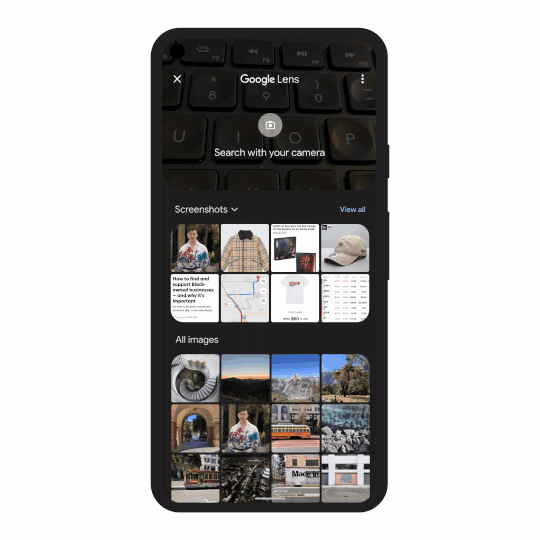
This functionality will increase the chances of prospective customers finding relevant products and purchasing online. Currently there is a disconnect between what searchers find in Google Images and what they can find in traditional Search – MUM will provide a valuable bridge between the two search methods.
Another exciting addition to Google Lens will be the suggested ‘Products’ CTA while looking at an image. The search engine giant announced that users will be given related searches after taking a picture of something, such as a broken bike piece, including a ‘shop’ search.
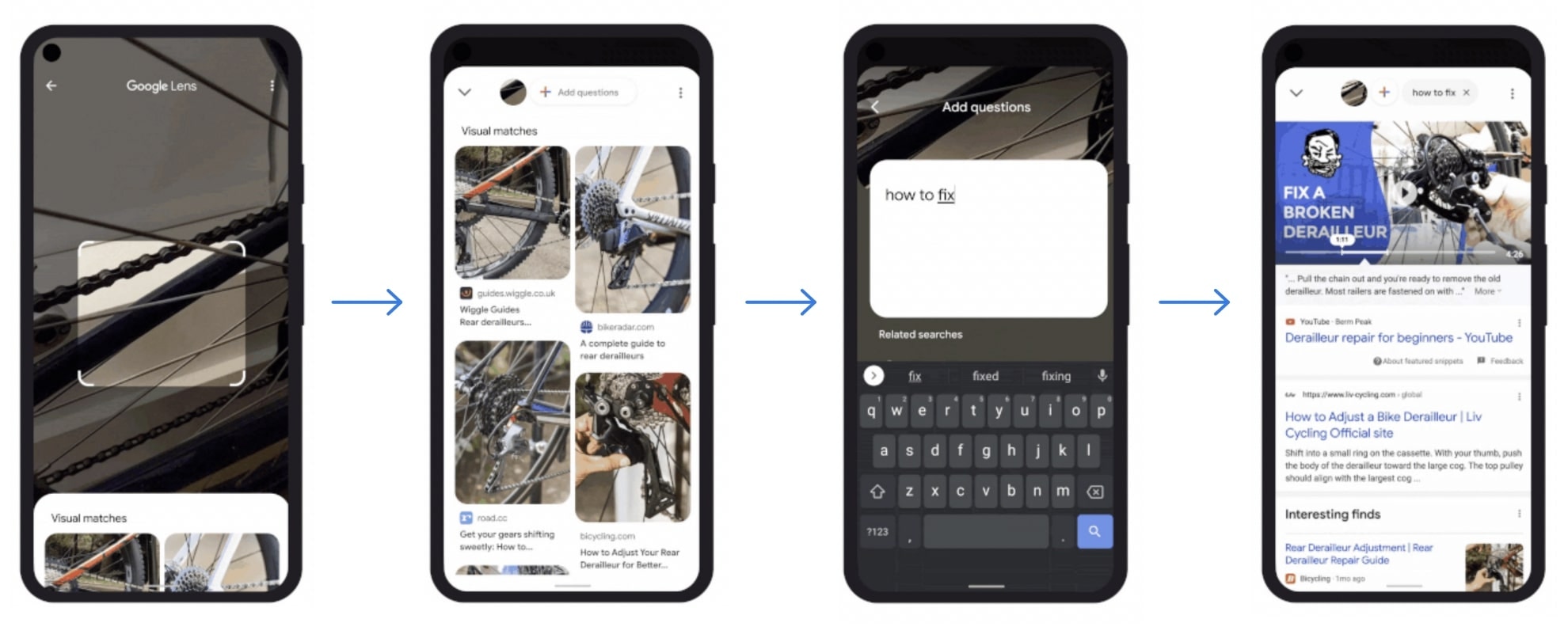
This will again encourage searchers with purchasing intent further down the conversion funnel.
As well as being integrated into Google Lens, MUM is set to be introduced to Google’s traditional search algorithms in 2022. One of the innovations it will bring is removing language barriers when looking for information. MUM is able to analyse the information from articles written in a language different to the one you are searching in and retrieve the information in your chosen language.
For the ecommerce space, this could help grow brand awareness in existing and future international markets by sharing your expertise with customers around the world. MUM will introduce audiences to businesses that they have never previously engaged with.
Next steps for marketers
To be eligible for showing in the Google Lens shopping results, your SEO team will need to ensure that they:
- Upload product information to Google Merchant Centre
- Opt in to Free Product Listings
- Follow Google Image best practices
In 2022, keep your eyes peeled for its release!
The integration of the MUM algorithm with Google Lens does not yet have a firm release date, with Google only revealing that it would be widely rolled out in early 2022. Whenever the functionality does arrive, it is likely only a matter of time until it is made available on traditional Google search. This could accelerate the growth of a whole new search method tied to transactional intent, to the benefit of ecommerce businesses investing in SEO.
Improving user experience

You only need to take one look at Google’s 172 page Search Quality Rater Guidelines to know that the search engine places strong emphasis on quality content production. In 2022, I don’t expect to see a change in the prioritisation of quality content and I predict that we’ll see a greater focus on content which improves the user experience.
From product descriptions to buying guides; content permeates every single aspect of the buyer journey from awareness through to conversion. Businesses can no longer expect to get by doing the bare minimum that’s required to have a functioning ecommerce website. They should be looking for ways to attract, educate, engage and delight their existing and potential customers in order to capture a bigger share of the market.
Focusing on tightening up your product-led content strategy can help to improve rankings, leads and conversions but we know that resource, budget, and buy-in often act as barriers to this blue sky thinking. 2022 is the year that you should be exploring ways to improve the user experience for your potential customers.
Next steps for marketers
- Set aside time to revisit and refresh, or create, your audience personas
There’s not a single person whose day to day hasn’t changed in some way after the past two years, so take the time to reassess your target audience’s hopes and fears, needs and wants. This exercise will help to clarify who you are writing for and ensure that your customer is at the heart of everything that you do!
- Content with a clear commercial purpose
One of the largest barriers that you may have to overcome is getting buy-in from stakeholders to produce content as part of your strategy. While traffic and rankings are nice metrics for someone that works in SEO to report on, when it comes to getting stakeholders excited about content you need to be talking (or typing) in cold hard cash, showing that you’re considering ROI at every opportunity.
The creation of long, quality, content will not only have a positive impact on your ranking performance but can also be a driver of revenue and growth, too. Get into the mindset of your audience personas and use this as an exercise to spot gaps in your existing content strategy and on-site content.
Perhaps your customer is worried about investing in a product that won’t last very long so they’ll have to keep re-purchasing and spending more money. Could you signal your warranty and quality hallmarks more clearly on product pages? Could your reviews be more prominent? Could you create a buying guide on what to look for when making a purchase and how to spot a product that will last a lifetime to help ease their concerns?
- Focus on improving the user experience with rich media
Whether you’re talking product descriptions, category content or buying guides; rich media will help your customers to engage with your products in a way that closely mimics the experience of shopping in-store.
One way that you could look to improve your customers shopping experience could be by investing in video. In a recent survey published by Statista, over 27% of respondents watched over 10 hours of video online per week. People love video content as can be seen by the monumental growth of platforms such as TikTok, YouTube and even Instagram reels. For businesses, there’s a captive audience looking at their screens right now, ready to absorb your content.
You can use video content in a multitude of ways including supporting ranking performance through YouTube-specific keyword research and video optimisation; helping you to reach a new and broader audience. You can look at improving conversion rates by incorporating product videos and user-generated content at product level (ASOS do this well by recording short videos snippets of their clothes on models so you can see how they fit and flow). Finally, you could ease the flow between awareness, desire, and purchase by peppering your buying guides and content with rich media to help your customers visualise your products in their life.
If you haven’t got an account or page set up already, that’s your first step! Be sure to think about where your customers are likely to be spending their time (for example, a 50-year old person looking for insurance might not be on TikTok but could be on YouTube) and then optimise your channel page with a description of who you are and what you do.
Your content assets can also act as assets for other disciplines, too! If you’re working with paid social, PPC and digital PR teams then get them involved in ideation sessions. The information that they have available will help you to tighten up your content strategy and ensure that it’s hyper-focused on your audience and commercial goals.
As a few examples; your friends in paid social will be able to tell you what content is working well with what audiences and you can refine or plan further content to market to these groups. You could share your buying guides with the paid media team and use them for dynamic search ads, remarketing, or even as a lead generation tool!
Ask your PPC team to share ad copy results and incorporate them into your metadata or product descriptions – they have tested what works, so why reinvent the wheel?
Share your ideas with your CRO team who may be able to help you test and hypothesize the impact of category content or product descriptions.
Share your guides with your Digital PR team who may be able to use ideas for thought leadership.
In 2022, focus on delighting, educating and inspiring your existing and potential customers with content that enhances their experience with your business.
Navigating supply chain challenges

Ever-changing lockdown rules and restrictions have left ecommerce businesses facing challenges in navigating fluctuating demand and stock levels. It was recently announced that due to a shortage of workers and disruption caused by COVID and Brexit, major retailers’ stock levels are at their lowest since 1983. According to the BBC, product shortages and supply chain issues are predicted to continue into 2022 with Ikea’s chief executive forecasting stock difficulties until next August.
We’ve dealt with a variety of different clients facing stock issues either as a result of a surge in consumer demand or soaring import prices. During peak lockdown, demand for ecommerce goods saw an uplift but the chain reaction of this saw the average cost of shipping goods from China to Europe quadruple. The increased demand in freight overseas can be seen on the below graph.
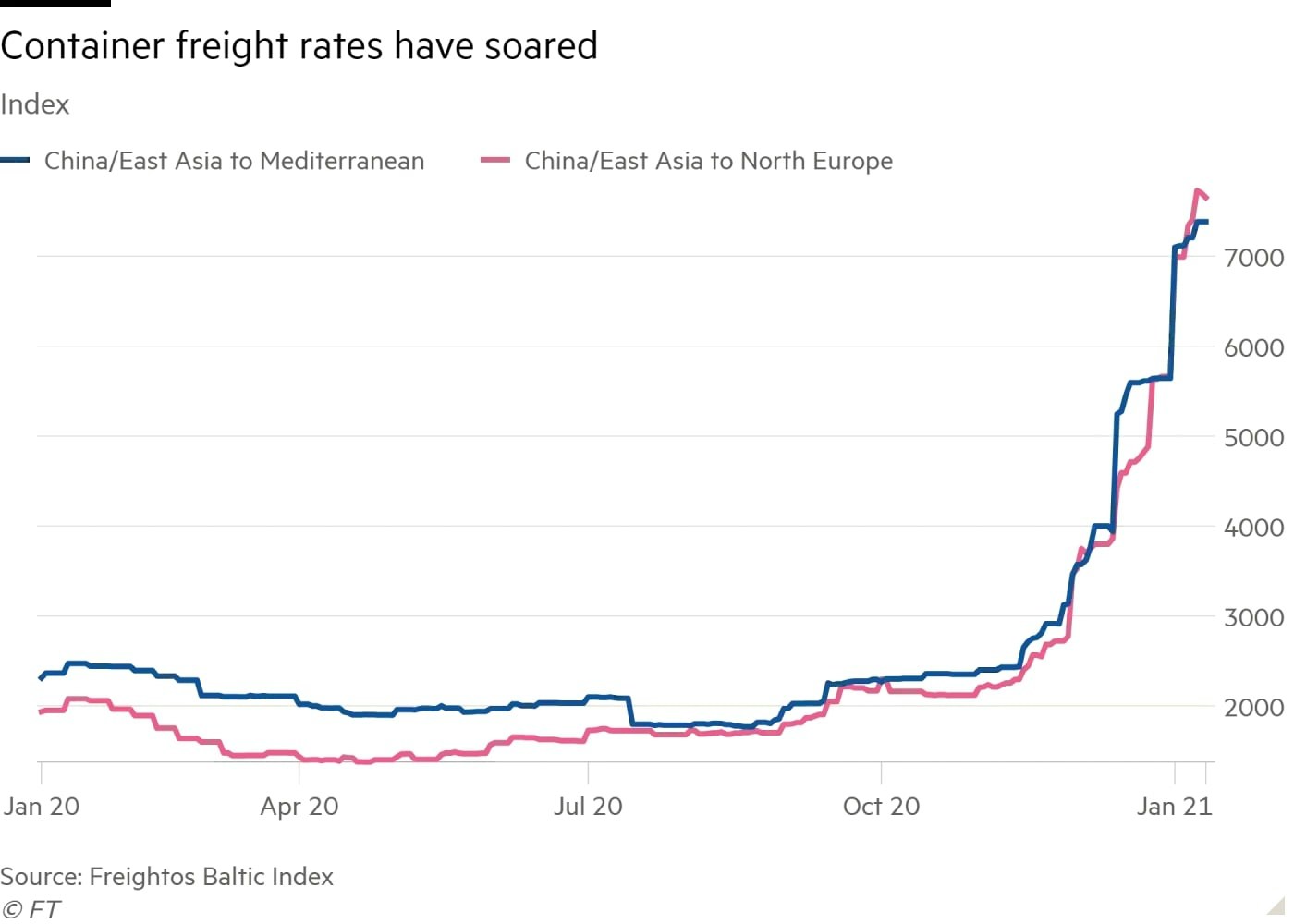
As we prepare to continue to battle supply chain issues throughout 2022, CNBC warns businesses that being able to manage these problems will become a core competence. Future proofing your strategy and factoring this in is imperative.
From a retailer’s perspective, you may choose to pass the price hike onto your consumer or you may choose to take a hit on your margin, absorbing the higher supply cost. The ultimate result of this is much tighter margins, meaning that any sale discounts are likely to be lower than in previous years as you pivot focus on higher margin products.
To support your business in 2022 and beyond, there are various techniques and tactics that your paid media team can implement to make your budget work harder and to support your business’ margin and gross profit goals.
Next steps for marketers
There are a couple of key attributes that would be extremely valuable to add into your shopping product feed to help you to manage inevitable stock challenges in 2022:
The Cost Of Goods Sold feed attribute looks at adding in the price in which a retailer pays to purchase the product from the manufacturer or the cost to produce the product. The value added here is being able to use feed rules to automatically create margin brackets as custom labels and assign bidding strategies on gross profit rather than revenue. As we mentioned before, margins are tighter than ever, so having profit over revenue will be your key to success.
The Sell On Google Quantity is another key attribute that needs to be within your product feed. This attribute lets Google and your consumer know how many variants of this product are left in stock. As a business it might make sense to only spend marketing budget on products where you have a stock depth of greater than five. A simple feed rule, to say when quantity is less than five, exclude this product from shopping ads will be a quick win (Excluded destination [excluded_destination] – Google Merchant Center Help).
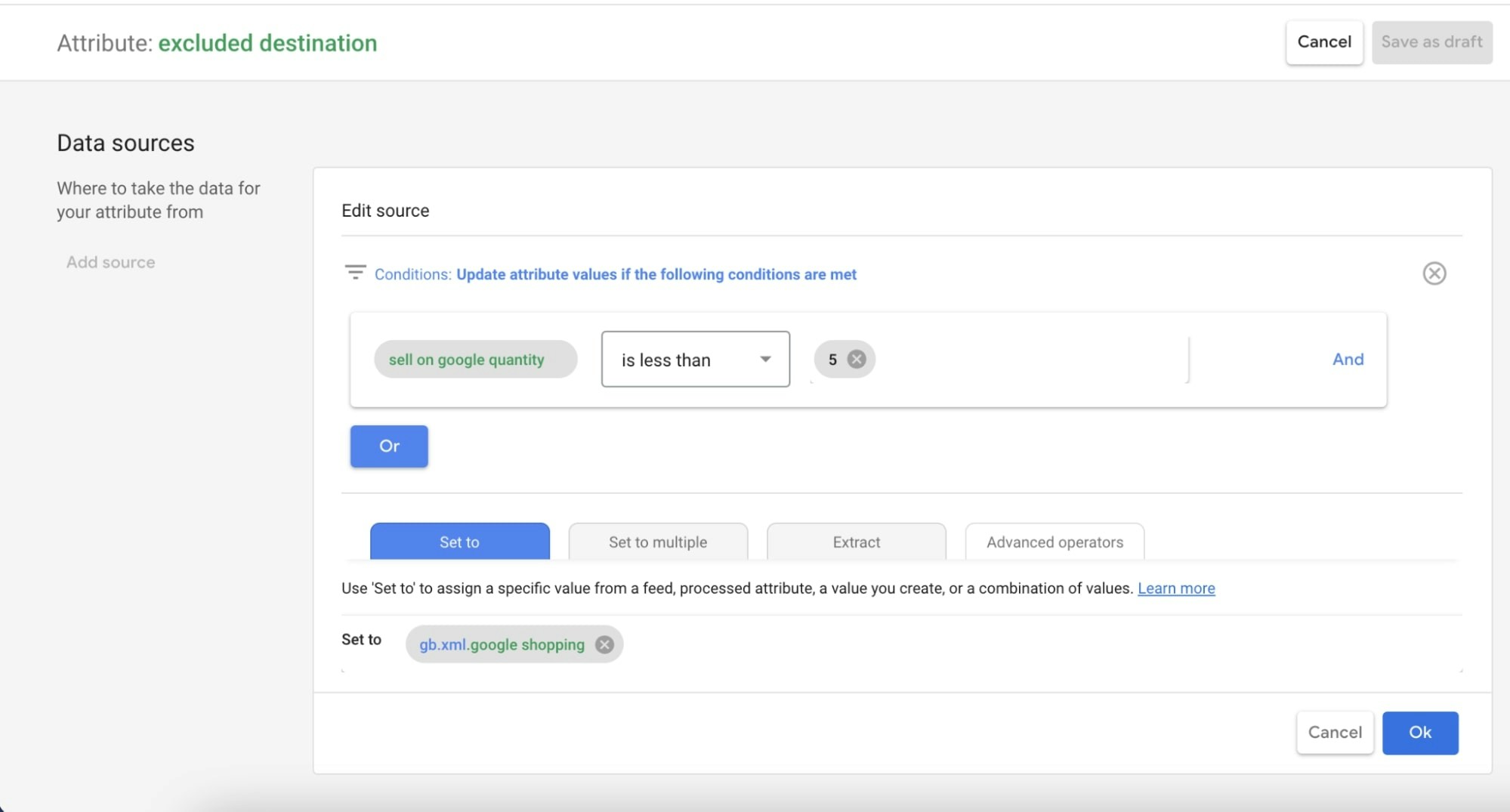
Once you have added margin and quantity data into your shopping feed, you can alter bid strategies and budgets to be more aggressive for the high stock and high margin products. In addition, custom reports in Google Ads (segmented by custom labels) are a great way to gain visibility into performance and potentially segment CPA or ROAS targets based on margin rather than revenue.
You can also use inventory managed campaigns (SA360 feature) to dynamically insert product feed data into your search campaigns. This method has a slightly different goal of using the low levels in stock to drive demand and urgency from a consumer perspective.
From the ad preview tool below, we have been able to pull in live data from the product feed into the search campaigns to demonstrate the price of the product and current levels of stock.
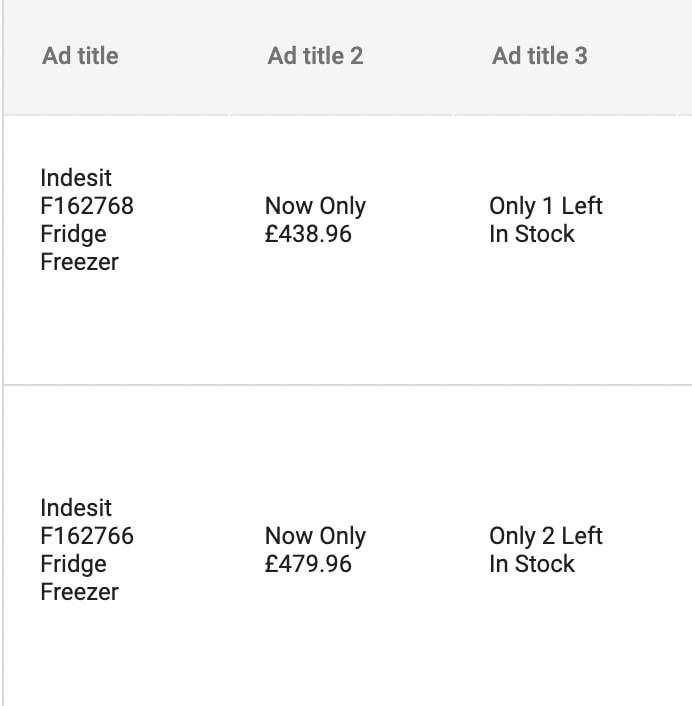
This is a slightly different strategy but has driven significant improvements in conversion rate when there are only a few products left in stock.
Trends in many aspects of digital point to a “race to the bottom” on price, and this is driven by the significant, and growing investments into channels such as inbound search, powering search ads and shopping spend.
In order to be resilient to price, businesses’ and their marketing efforts need a stronger proposition, centered around a point of differentiation. This could be quality, aftercare, warranty, delivery (speed, price, hours/availability), or other value-adding experiences for the consumer, perhaps even including access to a purchasers’ community.
Reviews also continue to be incredibly important in online retail, especially those verifiable by third parties with integrations into other marketing channels and the buyers’ own purchase journey.
We still see a lot of advertising businesses that are only active on a small number of digital marketing channels, and typically these are those where price is such a large factor in listing and purchasers’ consideration. For companies who can compete on more points of differentiation, this opens up the opportunity for more storytelling in their advertising, allowing consumers to build more of a connection with the brand.
Once emotions come into play in a purchasing decision, and for products which are not commoditised, price is less of a barrier, as holds traditional marketing theory. As inbound marketing channels (i.e. Google Search) gets more competitive, brands that can generate sales effectively from a more diverse set of channels may be able to outperform in their category.
Next steps for marketers
As a marketer, ensure that you regularly consider your full value proposition. What ‘delight’ moments could be added to your shoppers’ experience? Is your online shopping experience seamless? If you have physical stores, how connected is your online and offline shopping experience?
If you believe your offer is compelling enough, consider how you can utilise display and social advertising channels to reach and begin to educate new audiences. These consumers will be ‘colder’ than inbound search and will have less propensity to purchase, however build inspiration and desire among this cohort and retarget them carefully to drum up additional product/brand interest.
When price is the deciding factor that you’re competing on, then unfortunately high growth will be very difficult without the activity being a net cost. Depending on the lifetime value of customers, the acquisition efforts may be worth it, but proceed with caution.
Customer Data Platforms in principle aren’t really that new, but it’s a relatively new name and combination of CRM, analytics and marketing automation features and we still see many businesses out there without an effective complete single customer view.
Having a complete customer view is crucial in ecommerce as this allows the true measurement of new customer acquisition as opposed to capturing existing ones. Without the technology running in the background which powers this all in one place, then any marketing activation work will risk decreases in the quality of targeting.
Customer Data Platforms are essentially the modern versions of CRMs – Customer Relationship Management databases. Typically CDPs are fed by multiple data sources, which would include in the case of a retailer, point of sale as well as website conversions and events. Crucially CDPs include all first party data whether or not the customer is identifiable. If the customer later becomes identifiable, then the history that can be claimed by that identity would be attached to their record, giving rich ‘look-back’ data abilities. This could be via loyalty schemes, website traffic and conversion matching, email marketing landing page sessions, or through other marketing channels/partners enabling the identity matching. CDPs typically have outputs as well as inputs, many of the modern retail CDPs for example include email marketing functionality and also advertising audience syncing, too, which are increasingly important to have up to date.
Why are CDPs important?
Single customer views ensure that we’re able to identify known customers from unknown ones, meaning we can deliver the right messaging to the right customer, at the right time.
In combination with lifetime value modelling or projections, we can get a better understanding on what an acceptable customer acquisition cost is. Typically this can be higher in organisations where it’s recognisable that there’s a higher lifetime value. Tying together lifetime values is incredibly important for ecommerce and retail businesses for this very reason.
With a CDP typically all data is real-time, or close to it. This means reactivity is key, no wasted spend or leakage in targeting. And there’s a tangible reporting benefit too: even having a CDP that holds complete data means you’ve had to break down so many data silos across the organisation. From stores to ecommerce, CRM and loyalty (among other departments), all departments operate from a single view with the customer at the center. This means reporting is efficient and everyone’s looking at the same data source, and there’s no time wasted on comparisons and data cleaning.
Next steps for marketers
Consider where your customer/audience data lives in your organisation. This is excluding anonymous third party audience definitions which might live in your Data Management Platform. When considering your customer data, where is it, and how many departments or functions does it sit across? Can it be centralised? Can you get a competitive advantage by moving to an online CDP instead of your existing solution? What inputs and outputs would your CDP system need in order to be effective? Definitely use the time to speak with your advertising teams and partners to help, too.
CDPs should sit in the center of your data strategy. In particular CDPs will integrate well with addressable audiences, which in online terms are CRM (you might call this “email” or “CRM” in your organisation) and advertising, and offline it means loyalty and data capture at point of sale, among a few other specifics.
Conclusion
The world of ecommerce changes at a pace that isn’t easy for any marketer to keep up with. Combine this with ever-changing lockdown restrictions, increasing consumer demands, stock challenges and new innovations… It’s a tricky landscape to navigate. Keeping on top of the latest trends, being able to adapt your strategy and remaining agile will be the key to standing out against your competitors and seeing success in 2022.
We hope the advice and insights in this guide will help you to stay ahead of the curve next year. To keep on top of the latest news and updates in digital marketing, keep an eye on our blog or our library of resources, both are regularly updated by our own team of digital marketing experts. If you would like to discuss how any of these trends could be implemented into your own strategy, get in touch with our team today.
